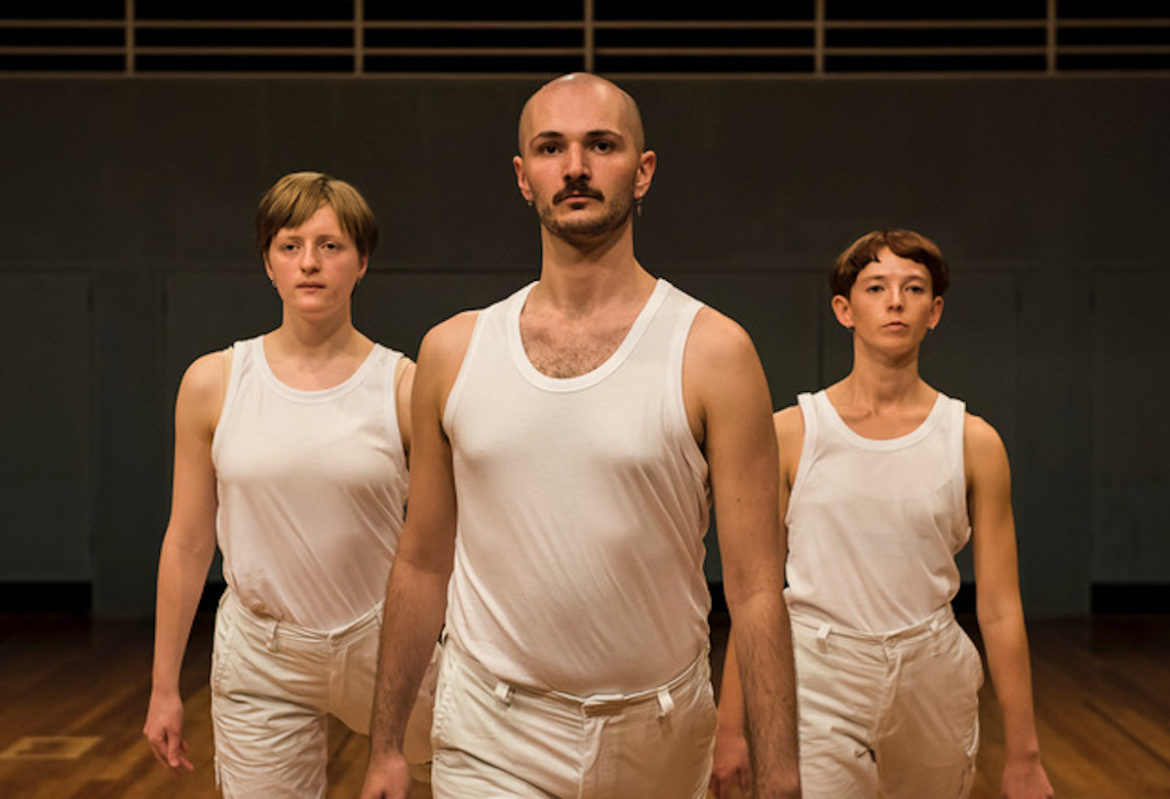With its regimented, mechnical movement, Sandra Parker’s Adherence recalls a science fiction dystopia, says Robert Reid
In the austere Iwaki Auditorium in the ABC studios, three dancers clad in white face each other from either end of the room. They warm up at either end of the hall as we file in.
The floor of the studio is wooden like a basketball court. The room itself has a functional quality that gestures towards art nouveau industrial design. One can imagine these pale blue walls and white railings belong to a ship of the White Star line. The seats that almost topple over each other, looking down into the space, still echo with the chamber orchestra recitals of the ABC orchestras and the excellences of another era.
There is a whistling, grinding abstract soundtrack that breathes and wheezes subtly as we enter. I think it’s the air con to start with, until it falls silent as the work beings and then starts again; a new tone, deeper, broken up with rhythmical rises and falls in the volume. A quiet, insistent pulse carved out of silences in static persists throughout. It’s kept by the breaks in the noise, like a machine breathing, and later by monotonous beeps that recall a heart rate monitor. It’s calm, measured. There is no excitement, no heart pounding that doesn’t come of slow, regular, gradually building levels of exertion.
The three remain in mostly lockstep synchronisation throughout. Each moves through the same, or mirrored versions, of the action. As the work progresses, the synchronisation gradually decays, though only slightly. The physical reality of the dancers’ bodies imposes itself as the demands of the movement become more demanding. Shirts are removed, sweat is wiped away, the water waiting at the side in white cups is drunk more and more.
Everything is white and minimalist, drawing attention to the slightest shifts, the small changes, the inconsistencies. A tired dancer’s leg that folds more than the others. An errant hand, extended thumb up instead of thumb down. The gentle thud of heels hitting the floor together, first one, then two and three individual thuds.
Four acts in the dance are signalled by the display of a large number, printed black on white, shown to each dancer and the audience, recalling the wrestling card between matches. The movements begin slowly. Synchronised 90 degree turns that slowly become more complicated. Adding complexity with each repetition, it’s a kinetic fractal: the deeper one looks at the detail, the more it repeats itself.
The movements are regimented like coordinated exercises in a Filipino prison yard gone viral on YouTube. Ritualistic, if not ritualised, like an ever more demanding Salute to the Sun. Each of the four acts grows more complicated while remaining rigidly broken into repeatable segments that are reorderable and modular. Variation within variation allows for small patterns to emerge out of larger, longer patterns, only to return to the beginning of a cycle just as you forget it was a thing.
Without drawing any kind of narrative, the repetition and complexity and silent, expressionless faces illustrate a mechanical adherence to a set of rules and rituals that we’re not privy to. What dystopic nightmare world of all-white clothes and objects exists outside this dance? It recalls the science fiction films Logan’s Run and Soylent Green.
It finds its end in circularity, returning to the number one and lining up as if to begin the whole process over again. The piece holds its breath for a moment here, before relenting and letting us applaud.
Adherence, choreographed by Sandra Parker. Sound design by Amelia Barden, Costume by Helene Froisland. Performed by Chloe Arnott, Arabella Frahn-Starkie and Jonathon Havakis. Iwaki Auditorium. Closed.

